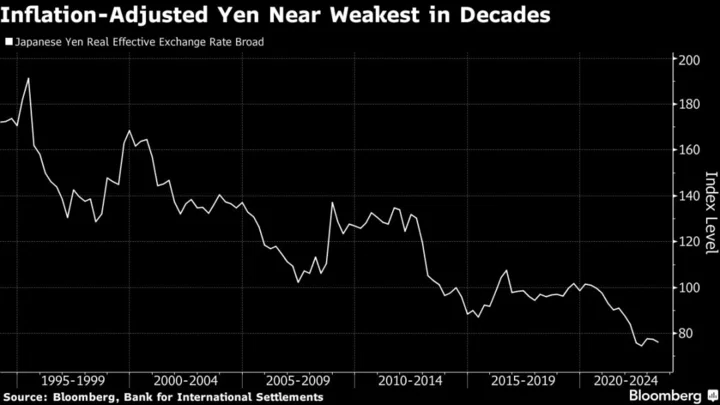It just may have been the week that broke the dollar.
The greenback’s worst slump since November has a bevy of strategists and investors saying a turning point is finally at hand for the world’s primary reserve currency. If they’re right, there will be far-reaching consequences for global economies and financial markets.
The US currency is teetering at the lowest level in more than a year after signs of cooling inflation bolstered bets that the Federal Reserve will soon stop hiking interest rates. Dollar bears are looking even further ahead, to what they say are inevitable rate cuts, something the market consensus sees happening at some point in 2024.
“Our call for the dollar to enter a multi-year downtrend is partly based on the fact that the Fed’s tightening cycle will morph into an easing cycle, and this will pull the dollar down even as other central banks cut as well,” Steven Barrow, head of G-10 strategy at Standard Bank, said in a note on Friday.
It’s hard to overstate the potential ripple effects from a long-term greenback slide. It would reduce import prices for developing nations, helping ease their inflation pressures. A greenback reversal also stands to bolster currencies like the yen, which has been tumbling for months, and upend popular trading strategies tied to a weaker yen. More broadly, a softer US currency would tend to boost American firms’ exports at the expense of their counterparts in Europe, Asia and elsewhere.
The Bloomberg dollar index’s 2% decline last week also contributed to gains in greenback-priced commodities such as oil and gold.
Many investors have been waiting for a downtrend in the dollar for months and the selloff has fund managers from M&G Investments to UBS Asset Management bracing for an outperformance in the likes of the yen and emerging-market currencies.
“The most likely path forward is the dollar remains weak throughout the coming months,” said Peter Vassallo, a fund manager at BNP Paribas Asset Management. He’s betting on gains for the Australian dollar, New Zealand dollar and Norwegian krone.
What Bloomberg Strategists Say:
The prevailing downwards trend in the dollar is primed to remain intact while the real yield curve flattens. One of the best leading indicators for the dollar, for instance, is the real yield curve. The intuition is the dollar is driven at the margin by the real return of foreign investors into US yields.
- Simon White, macro strategist.
Of course, there’s a long history of investors getting burned by premature bets on Fed rate cuts that would sink the dollar. That was the case early this year, when the currency seemed to be on the verge of a protracted downtrend only to stabilize as US economic data drove home that the Fed wasn’t about to stop hiking.
For the bears, the threat is that dynamic repeats itself, especially with the Fed likely to tighten further as soon as this month.
At Invesco Asset Management, Georgina Taylor isn’t prepared to reduce her dollar exposure just yet. Still firmly in data-watching mode, she’s not ready to conclude the battle to tame inflation is over.
“The interest-rate differential story is wavering but I wouldn’t give up on the dollar,” she said, given that the absolute difference in real yields remains high.
US economic resilience is the reason Michael Cahill at Goldman Sachs Group Inc. expects any dollar downturn will likely be shallower than in past cycles. Dollar support could crumble, however, if the Fed calls an end to its inflation fight even as the European Central Bank is compelled to keep rates higher for longer.
“The biggest risk that could lead to more dollar downside is that the inflation picture diverges,” said Cahill, a G-10 FX strategist. The bank forecasts the dollar will weaken to $1.15 per euro in 2024, from about $1.12 now, and that the yen will strengthen to 125 per dollar, from roughly 139 now.
Dollar bears can also lean on valuation measures. The currency’s strength has been particularly pronounced against the yen, to the point where the real effective exchange rate has Japan’s currency trading near its lowest level in decades.
‘From a valuation perspective, the dollar is still very overvalued,” said Paresh Upadhyaya, director of currency strategy at Amundi Asset Management. “I think markets are going to start to fade that.”
He points to the US’s twin deficits — its trade and budgetary shortfalls — as structural headwinds. But he also has in mind another dynamic that market watchers often cite, the dollar smile theory.
Read More: Wall Street Is Buying Into Dollar Smile Theory at a Frantic Pace
The thinking there is that the greenback typically gains when the US is either in a severe slump or a robust expansion — and falters in times of moderate growth.
“If the US engineers a soft landing, that is probably the best case for a weaker dollar you can ask for,” Upadhyaya said.
--With assistance from Nour Al Ali.

